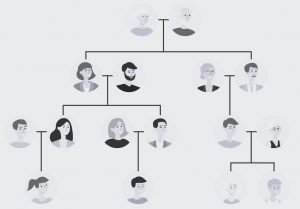Family Tree, How To
Researching your family tree can be a fun and interesting project to do. However, where do you start? With so many different sources out there to help you, it can be a bit daunting. There are family tree books, magazines, audiobooks, online options and even DNA tests! However, what if you want to do it for free and by yourself. Here are some ‘how to’ steps on how to research and do your own family tree.
Start with your own family
The best way to get started is to add the first four generations of your family. Start by writing down the date and place of birth, date of marriage (if applicable) and then add the same details for your spouse, children, grandchildren and parents. If anyone in this immediate family had died, those dates need to be included. This provides the very start of your family tree.
Draw a family tree
Now that you have collected dates, names and information of your immediate family you can start drawing up a basic family tree chart. Starting with the youngest generation at the bottom of the page, each person has a box, and siblings are listed from eldest to youngest left to right. Then connect siblings via vertical lines and connect them to parents with horizontal lines, with the father on the left and mother on the right. Then write the parents’ crucial dates as in generation one, creating a new horizontal line of ancestors for each generation. We have provided an example of this here.


Work backwards
Wherever there are blanks, start from the most recent generation and work backwards. Even if you are tempted to start in the past, always work backwards from yourself, finding your parents, then their parents, and so on.
Gather extended family information
You can now work by adding on other family members, such as your siblings, their children, your parent’s siblings and their children and so on working back generation-by-generation.
After searching your own home and personal records, ask other family members for their records and family history treasures. This can help you with dates and data to complete the more unknown family members and details.
Discovering more records
Besides just entering dates and places into your family tree, you can also include precious family documents, photos, birth certificates, marriage certificates, letters, diaries even newspaper clippings. Getting the missing information you require can be done via other channels, including:
- Birth, death and marriage certificate record services to discover more ancestors. Birth certificates have the names and occupation of the parents, marriage certificates provide age and occupations and parents’ names at birth, and death certificatesgive age and cause of death.
- Your local library, local Australia Family History Centre or National Archives of Australia office are often worth a visit to obtain more information for your family tree. You will be able to view original documents, browse maps and plans, and even see if any workshops are available. Call ahead in case bookings are required or to check opening times.
- There are many online sources for family records. Some Australian websites that are free to use include:
- familyhistorydaily.com/free-genealogy-resources/free-genealogy-sites-for-australia-and-new-zealand/
- www.myancestors.com.au/
- www.nla.gov.au/research-guides/family-history#
- www.naa.gov.au/explore-collection/search-people/researching-your-family
- www.findmypast.com.au/page/free-ancestry-records
- www.cyndislist.com/australia/general/
- For those with genealogy in the United Kingdom, there are some free UK options for finding family records. These include the National Archives catalogue and Cyndi’s List, both of which are great starting points for online research in the UK.
Organising your research
As you discover more ancestors, you will find it more important to keep track of your paperwork or online research. It is a good idea to start a research record early on, recording all the information and sources as you go. Things to record include ancestor’s names, important dates, notes on any paperwork related to them and copies of related important documents and where you obtained the data.
If you log all your findings electronically, remember to back-up your data with either a memory stick or into the cloud.
Make copies of paper work and save them electronically and store/file all your genealogy paperwork in one place or file. File these paper records and notes by family, geography or source so you can refer to them again easily.
Family tree software programs are also available and can make recording everything, including audio snippets easy.
Next steps
Once you have exhausted all the sources listed above, you may want to travel to the places where your ancestors lived. Local churches, cemeteries and other places where old records are kept may have more information to fill in more of your family tree. Bringing your heritage to life in this way is often a great holiday idea!
Share your family tree
Now that you’ve made your family tree, show it off! Print out your family tree, frame it, or put it online and share it with loved ones. Sharing your genealogy with others can help you add stories and family members to your own research. You never know what else you may learn and how your family tree with grow.
One of the best things about tracing your ancestors is that this is a quest that you can enjoy for years to come.
Summary
- Search your own records
- Start your family tree drawing with the 4 current generations
- Extend your search to family and their records
- Go online or to other services that provide records in your state
- Visit where your ancestors lived (if you can)
- Share your research.
More tips and advice
If you want more tips, online sources or help it is all out there. This site has some great searching tips Google search tips for genealogists here along with a list of the 100 best genealogy websites here Best Websites section, these aren’t Australian based websites, but still have some helpful advice and further links.
FamilySearch.org has a large collection of free genealogy records. Sites like Ancestry.com and www.myheritage.com/ have fees to subscribe and access records. However, keep an eye out for free trials that you can utilise on the paid websites, just remember to read and follow the terms and conditions thoroughly to avoid unnecessary fees. Another idea is to check if your local library offers the subscriptions sites like ancestry.com free on its computers.
Interested in similar articles? Why not check these out:
The benefits of more time outdoors
Sources:
www.family-tree.co.uk/getting-started/getting-started/how-to-start-your-family-tree/
www.familysearch.org/en/blog/how-to-start-a-family-tree











